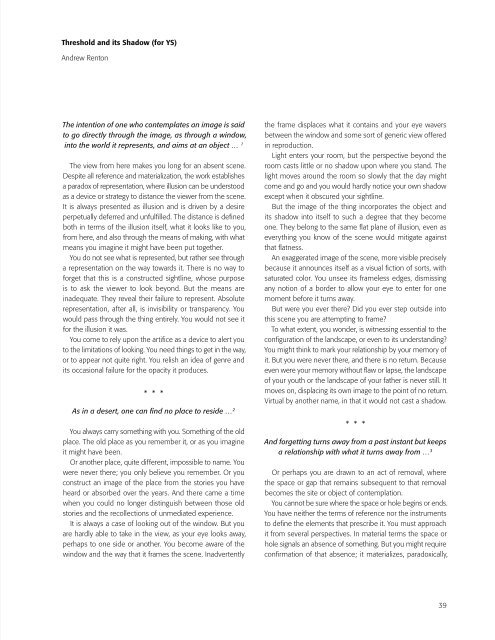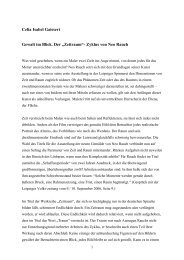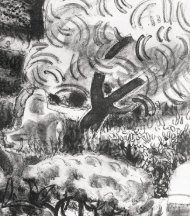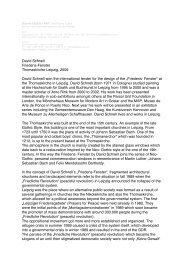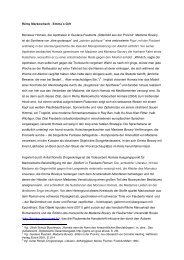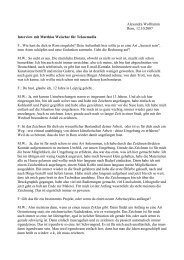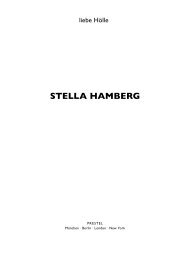YEHUDIT SASPORTAS - Galerie EIGEN+ART
YEHUDIT SASPORTAS - Galerie EIGEN+ART
YEHUDIT SASPORTAS - Galerie EIGEN+ART
You also want an ePaper? Increase the reach of your titles
YUMPU automatically turns print PDFs into web optimized ePapers that Google loves.
Threshold and its Shadow (for YS)<br />
Andrew Renton<br />
The intention of one who contemplates an image is said<br />
to go directly through the image, as through a window,<br />
into the world it represents, and aims at an object … 1<br />
The view from here makes you long for an absent scene.<br />
Despite all reference and materialization, the work establishes<br />
a paradox of representation, where illusion can be understood<br />
as a device or strategy to distance the viewer from the scene.<br />
It is always presented as illusion and is driven by a desire<br />
perpetually deferred and unfulfilled. The distance is defined<br />
both in terms of the illusion itself, what it looks like to you,<br />
from here, and also through the means of making, with what<br />
means you imagine it might have been put together.<br />
You do not see what is represented, but rather see through<br />
a representation on the way towards it. There is no way to<br />
forget that this is a constructed sightline, whose purpose<br />
is to ask the viewer to look beyond. But the means are<br />
inadequate. They reveal their failure to represent. Absolute<br />
representation, after all, is invisibility or transparency. You<br />
would pass through the thing entirely. You would not see it<br />
for the illusion it was.<br />
You come to rely upon the artifice as a device to alert you<br />
to the limitations of looking. You need things to get in the way,<br />
or to appear not quite right. You relish an idea of genre and<br />
its occasional failure for the opacity it produces.<br />
‹ ‹ ‹<br />
As in a desert, one can find no place to reside … 2<br />
You always carry something with you. Something of the old<br />
place. The old place as you remember it, or as you imagine<br />
it might have been.<br />
Or another place, quite different, impossible to name. You<br />
were never there; you only believe you remember. Or you<br />
construct an image of the place from the stories you have<br />
heard or absorbed over the years. And there came a time<br />
when you could no longer distinguish between those old<br />
stories and the recollections of unmediated experience.<br />
It is always a case of looking out of the window. But you<br />
are hardly able to take in the view, as your eye looks away,<br />
perhaps to one side or another. You become aware of the<br />
window and the way that it frames the scene. Inadvertently<br />
the frame displaces what it contains and your eye wavers<br />
between the window and some sort of generic view offered<br />
in reproduction.<br />
Light enters your room, but the perspective beyond the<br />
room casts little or no shadow upon where you stand. The<br />
light moves around the room so slowly that the day might<br />
come and go and you would hardly notice your own shadow<br />
except when it obscured your sightline.<br />
But the image of the thing incorporates the object and<br />
its shadow into itself to such a degree that they become<br />
one. They belong to the same flat plane of illusion, even as<br />
everything you know of the scene would mitigate against<br />
that flatness.<br />
An exaggerated image of the scene, more visible precisely<br />
because it announces itself as a visual fiction of sorts, with<br />
saturated color. You unsee its frameless edges, dismissing<br />
any notion of a border to allow your eye to enter for one<br />
moment before it turns away.<br />
But were you ever there? Did you ever step outside into<br />
this scene you are attempting to frame?<br />
To what extent, you wonder, is witnessing essential to the<br />
configuration of the landscape, or even to its understanding?<br />
You might think to mark your relationship by your memory of<br />
it. But you were never there, and there is no return. Because<br />
even were your memory without flaw or lapse, the landscape<br />
of your youth or the landscape of your father is never still. It<br />
moves on, displacing its own image to the point of no return.<br />
Virtual by another name, in that it would not cast a shadow.<br />
‹ ‹ ‹<br />
And forgetting turns away from a past instant but keeps<br />
a relationship with what it turns away from … 3<br />
Or perhaps you are drawn to an act of removal, where<br />
the space or gap that remains subsequent to that removal<br />
becomes the site or object of contemplation.<br />
You cannot be sure where the space or hole begins or ends.<br />
You have neither the terms of reference nor the instruments<br />
to define the elements that prescribe it. You must approach<br />
it from several perspectives. In material terms the space or<br />
hole signals an absence of something. But you might require<br />
confirmation of that absence; it materializes, paradoxically,<br />
Innenseiten-05.indd 39 21.05.2007 0:18:31 Uhr<br />
39


